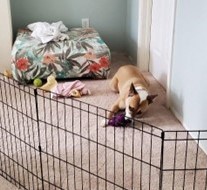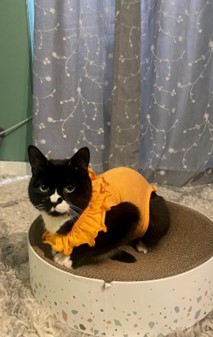LagriNet NEO Wipes

Image courtesy of Laura Gendron
If your pet has an upcoming surgery or is recovering from an injury or illness and the discharge instructions include exercise restriction and confinement, here are some ways to make this time as low stress as possible.
Consider what the requirements will be during recovery and prepare in advance. Does your pet need to be completely immobile? Is light activity acceptable? Do they need to avoid stairs? These are great questions to consider when gathering supplies and setting up space for the recovery period.
Restricting Activity
A Safe Haven: Establish a safe haven (What is a Safe Haven for Your Dog?) to provide a quiet place which includes a comfortable bed, toys, and feeding stations, and litterbox if needed. Depending on comfort level and required restrictions, this could be a crate or an entire room. Gates and exercise pens can prevent access to stairs and furniture jumping. Calming music and pheromones may be beneficial.
Enrichment
Enrichment is essential for pets, especially when regular exercise is restricted. To keep your pet’s mind active and engaged, incorporate beneficial activities like puzzle toys, lickable mats, and snuffle mats (Choose Your Enrichment Wisely). These tools provide mental stimulation while promoting restful behaviors. Moreover, positive reinforcement training can offer enrichment with minimal movement. Activities such as teaching your pet to touch a target (Training Series: Target Training Dogs with Touch), offer eye contact (Training Series: Teaching Eye Contact to a Dog), or relax on a mat (Mat Training in Dogs: Teaching to Station on the Mat), provide mental stimulation and help in maintaining calmness. These methods are important for your pet's mental health and well-being when physical activity is limited.
Leash Walks
Leash walks can be an option for your pet, depending on the level of exercise they are allowed. Using a front clip harness or a head collar, which can effectively reduce pulling when properly conditioned, makes walks more manageable and safer. It is also advisable to use a four-to-six-foot leash for better control (How to Stop Pulling). Short, frequent walks not only offer a chance for elimination but also give your pet an opportunity for some level of physical activity without overdoing it.
Post Surgical Equipment
It is important to be aware of the specific tools required for post-surgery recovery and to get your pet accustomed to these tools before the surgery. Ask for details like the location of the incision and what items like a cone or bootie are needed (Is Your Pet Afraid of the Cone? Other Alternatives?). Make sure the equipment fits properly to avoid situations where your pet may be inadequately protected during recovery. It is not ideal to discover that a cone is too short, or a body suit is too large when it is already needed.
Confinement Woes Shannon Emmons DVM

A cat wearing a body suit. Image Courtesy of Shannon Emmons, DVM
Introducing all new items slowly allows time for animals to get used to each one. Techniques such as luring, targeting, shaping, or capturing behaviors (Capturing Desirable Behaviors ) can encourage animals to willingly interact with these items, like putting their head through a cone or a foot in a bootie. The duration of wear can be gradually increased as they become more comfortable with the equipment.
confinement woes - re-entered

Image Courtesy of Shannon Emmons, DVM
Muzzle Training
For dogs, muzzles are an important safety tool and should be conditioned well in advance of any procedure where they might be required. Conditioning helps your dog become comfortable with wearing a muzzle, reducing stress and potential resistance when it is needed. Among the various types of muzzles available, a basket muzzle is often preferred. This style allows for the feeding of treats, which can be beneficial both for conditioning and during the procedure itself. Additionally, basket muzzles provide open airflow.
In terms of muzzle training, a slow and gradual approach is recommended (Desensitizing Your Dog to a Muzzle). The goal is to build positive associations with the muzzle. This process involves introducing the muzzle in a calm and non-threatening manner, allowing them to sniff and explore it at their own pace. Gradually, your dog can be encouraged to put their nose into the muzzle for short periods, while building duration slowly.
For dogs with unique facial structures or those that find standard muzzles uncomfortable, custom muzzles are an option. These are designed to fit the shape of a dog's face, for a comfortable and secure fit. These types of muzzles are especially useful for breeds with distinctive nose shapes or sizes, such as bulldogs and Dobermans.
Preparing a Fearful Pet for Elective Procedures
Preparing a fearful pet for elective procedures involves an individualized approach to reduce their fear, anxiety, and frustration. This is especially important for pets who are uncomfortable in veterinary settings. If the procedure is urgent, the use of Low Stress Handling® techniques is one way to do this.
If the procedure is not urgent, cooperative care training can be started in preparation. This training makes the procedure more predictable to your pet and provides a sense of control over what happens to them. Pets can learn to be voluntary participants in their own care, such as accepting handling, grooming, or medicating. This approach not only reduces stress during the actual procedure but also helps during their recovery, as a less stressed pet is likely to heal better and faster.
For some pets, medications may be needed to manage anxiety. This may include short-term or longer acting medications. These medications can make confinement and the overall experience of a veterinary procedure less stressful for them. It is important to consult with a veterinarian to determine the most appropriate medication and dosage for each pet. Combining medications with Low Stress Handling® techniques and cooperative care training can significantly improve the experience.